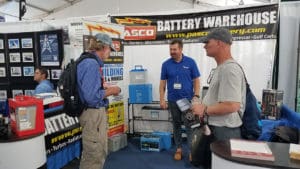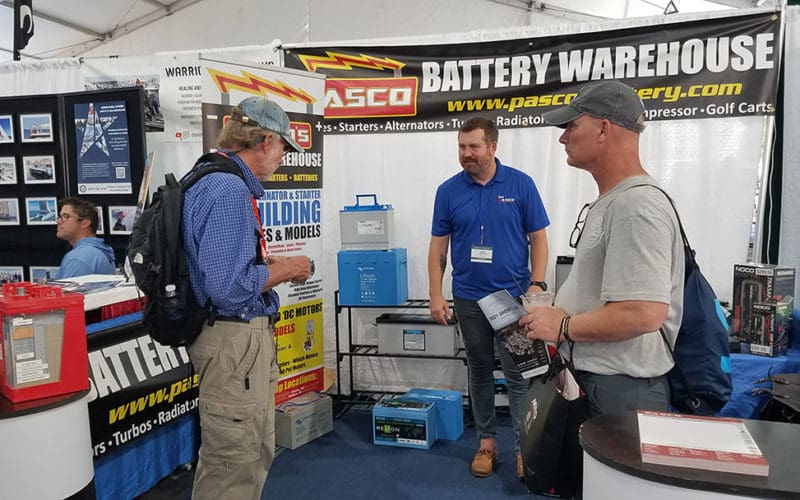
Twenty years ago my husband and I were inside a Florida Sam’s Club buying deep-cycle lead acid batteries for our Peterson 44. That same year the Maxi-cat Playstation set a transatlantic speed record with a lithium battery on board. It started a trend in boating.
In the years since then, how have lithium batteries done in the boating marketplace? At the 2021 US Sailboat Show in Annapolis I asked vendors whether they sold more lithium than lead acid batteries. Custom Marine Products’ Tom Trimmer said at the last pre-pandemic boat show people asked him to “tell me more about lithium.” Today they are saying, “I want this.”
But what is “this,” and are people moving from interest to purchase?
As recently as two years ago, companies like Battle Born marketed lithium batteries at the boat show largely as replacements for lead acid batteries. But lithium batteries are not truly drop-in; the whole system is too complex. eMarine’s Marc Doheny told me “You get people who’ve done their research and know exactly why they want lithium and others who say they want lithium but know nothing about it—those are the ones you have to watch.” Vendors agreed there’s a lot of misinformation and old information out there. While lithium is in ways finickier than lead acid, the technology has come far and properly set up provides many advantages for the average boater. To address the finickiness companies are offering complete systems.
What do cruising sailors think? While Nick Slater of Pasco Battery Warehouse called sailors the initial innovators (a position since taken over by powerboaters) I didn’t find a lot of enthusiasm for lithium among cruisers.
The main reason is still cost. One cruiser said the “initial cost is enormous.” Others weren’t as concerned by initial cost as by what follows: One thought weight and space savings (Lifeline’s lithium batteries weigh about 1/3 traditional lead batteries) would be offset by the temptation to put in a bigger battery bank, while another figured he “would probably need to replace one or two solar controllers and my external regulator and that makes it quite a bit more expensive.” All had invested time and effort in considering lithium.
CMP’s Tom Trimmer said “The initial cost of LiFePO4 batteries is up to four times that of lead acid.” He underlined the concern about having to change chargers and controllers but said this may not be an issue with their batteries.
Price difference
While lead acid batteries take various forms, your basic “flooded” 12 volt deep-cycle marine battery can be purchased for as little as $100. (It can also be purchased anywhere in the world where people run vehicles.) Lithium batteries run from around $400 for Chinese batteries to more than $1,000 for US ones. The cells that power lithium are almost entirely built in Asia but top-end batteries are generally assembled in the US. I currently own a Sabre 30 with two banks of two batteries each. Given that lithium batteries have about twice the charging capacity of lead acid, I might get away with just two, which at their cheapest would still be twice the cost of lead along with other system requirements.
The hesitation of cruisers isn’t just about cost. One cruiser who would likely soon be switching batteries out felt lithium prices had come down significantly but is concerned with safety. “Some expensive batteries claim to have internal protection from meltdown fires, but the catastrophic consequences of a fire offshore has me leaning towards older, more proven technology.” He does have cruising friends who made the switch and seem content with the risk. Indeed, most people know somebody who’s switched.
Lithium batteries do have a reputation for catching fire, but the LiFePO4 batteries offered by both CMP and Lifeline include a built-in Battery Management System (BMS) to monitor and balance cell groups and manage temperature, charge and discharge rates. If working properly, the BMS will prevent over-charging and over-discharging by disconnecting from the source. There are no toxic chemicals or gases as in many types of lead acid batteries and batteries can be mounted in any direction.
Built-in monitoring can make lithium safer and more efficient (hence the significantly increased charging capacity) but also leads to a reputation of complexity. The cruiser who expressed enormous cost difference also said “Typically, with lead, we use solar and wind and just leave them on to charge as needed. That doesn’t work for lithium.”
High energy density
According to the industry, with a proper set up you can indeed just leave lithium on, and in fact lithium batteries outperform lead acid in cruising situations. eMarine says that lithium batteries have “high energy density” making them a good choice for smaller boats.
Purchasing a lithium power system involves design and individual tailoring and can go against cruiser self-sufficiency. “The cost of a battery system replacement may be from $1,000 to $15,000 depending on the size of the installation and the amount of power needed. If you add a solar system it will be an additional $1,000 to $10,000,” said Trimmer, who teaches courses and works with customers to design a complete system that most effectively meets their boat needs.
Some cost is offset by the longer life span of lithium; well cared for batteries can last 10 years, compared to three to five years for a good lead acid setup. Considering the length of time of the average international cruise this should be sufficient.
Besides weight and life span what other qualities set lithium batteries apart? Lithium batteries will charge to almost 100%, getting the last 20% that lead acid misses. They charge much faster and a good charge is available quicker and stays up, dropping sharply at the end of the cycle. Also, an important point for anyone using them regularly, a 95% discharge won’t kill lithium batteries, though it might shorten the life span. BMS management maintains the cell balance that is necessary for optimum performance; this is not the same as topping up the fluid in lead acid batteries, but once a system is properly designed it requires a lot less maintenance than a lead acid charging system.
Vendors also describe the alternator as a possible weak link. Lithium batteries have low internal resistance and will run flat out as long as charging is needed. The small automotive alternators on most boats will overheat, which can damage the alternator which can then damage anything tied into your electrical system. A large alternator plus the BMS helps prevent this. Many cruising sailors add other sources of power generation, such as wind, or solar which Trimmer said works particularly well with lithium because it charges so quickly.
My sense is that outreach to cruising sailors, well known for thoroughly researching anything they do, has not been sufficient. There are some good education efforts out there, however. Dakota Lithium Batteries, for example, has a informative videos on its website (dakotalithium.com) explaining the pros and cons of lithium. While the physical disadvantages of lithium have been overcome, and the benefits can be great, they are not convinced about the cost increase, perhaps because most buy used boats with lead acid systems already in place. Starting out fresh with lithium would be psychologically easier. Trimmer of CMP says he will recommend that people who have functioning lead acid systems stay with them until they are dead and make the switch at replacement time.
But Trimmer, who works with boat manufacturers, said there is resistance from builders who don’t want to change their designs to accommodate the weight and size differential when customers want lithium in their new boats.
Companies are offering five-year warranties, and used lithium batteries hold their value. Lithium BMS computers are Bluetooth compatible and state of charge can be monitored from a smartphone.
I asked my husband what would be the tipping point for getting lithium for Ora Kali, our Sabre 30. He said, wistfully, “It would be nice to have reliable refrigeration.” Ours isn’t unreliable per se, but it’s hard for our small lead acid battery banks to keep up without endless charging.
Time for lithium? n
Ann Hoffner spent summer of 2021 sailing Ora Kali, her new Sabre 30, from New Jersey to Maine where she and her husband, co-sailor and photographer Tom Bailey, moved last year. The Sabre 30 marks a shift for the couple from bluewater to coastal cruising.

